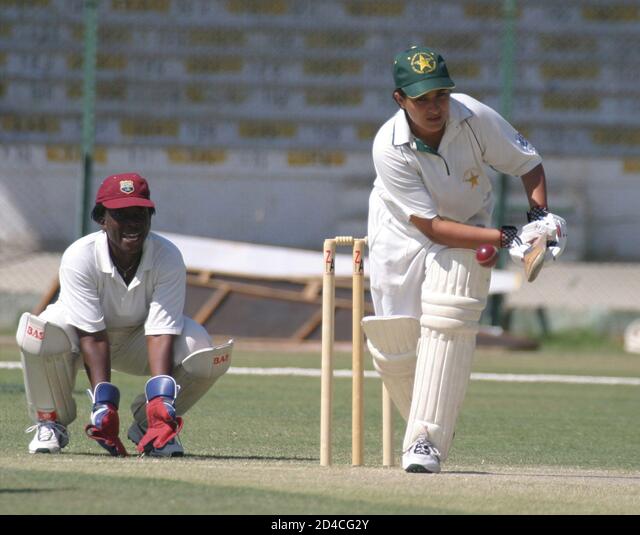This is the story of Kiran Baluch, trailblazing heroine who paved the way for the rise and transformation of women’s cricket in the country.
On March 16, 2004, amid rows of empty seats at the National Stadium Karachi, a woman cricketer raised her bat after reaching a milestone – a Test score of 242 – against all odds.
At the time, it was prohibited for men to watch a cricket match involving women in the stadium in Pakistan. As for women viewers, perhaps there wasn’t even one who could arrange a chaperone to sit in the stands.
Notwithstanding, Kiran Baluch raised her bat and green Pakistan cap. She knew that she had reached a feat that would have an effect on generations to come. It was a historic moment that deserved celebration.
This was more than just surpassing Mithali Raj’s world record Test score of 214 – it was a statement that broke shackles and gave a beacon of hope to women’s cricket in Pakistan. There was no TV or radio coverage, but, thankfully, someone on the ground captured that historic moment on camera.
Kiran came from an affluent and erudite home, so it was easier for her to follow her dream. As a child, she played many sports, but cricket always had a special place in her heart. It was her passion for the game that inspired her to pursue this sport.
In the 1990s, when women cricketers in Pakistan had no access to even basic facilities, they nevertheless received death threats. Always looming over them was the common perception that women could not play cricket. It was the ultimate insult, one perhaps even more demoralizing than the physical threats. But that didn’t stop Shaiza Khan and her sister Sharmeen Khan (now deceased) from paving the way for the creation of the Pakistan Women’s Cricket Control Association (PWCCA) in 1996.
In just eight years, and defying all odds, a member of the women’s team broke the world record for most runs in a Test inning. Even more impressive was the fact the team wasn’t even ranked as amateurs at the time.
Perhaps breaking that record converted a few mainstream cricket enthusiasts, but it had little overall effect on Pakistan’s cricketing fraternity.
Kiran has always remained bitter about the lack of encouragement women’s cricket got in its infancy stage, especially from their male counterparts. She once said that the most pleasing aspect of achieving the world record was proving the many people wrong who thought that the Pakistan team wasn’t capable of surviving in a four-day Test match. She reckoned that despite holding world records, women cricketers were disregarded by the male stalwarts of the sport.
Due to the dismissive national environment, Kiran and the Khan sisters often took solace playing cricket in England during summers.
From death threats to applause
When Kiran and Shaiza started out, they had foreign women and national men cricketers as role models. Now budding women cricketers have indigenous heroines like Sana Mir, Bismah Maroof, and Javeria Khan to look up to. The story of fast bowler Diana Baig making it from Gilgit Baltistan to the national team has become inspirational for many girls all over the country.
Now, cricket is being played by girls belonging to every segment of society; they come from all parts of the country – from coastal Karachi to the northern valleys of Gilgit-Baltistan – with a shared dream to represent their country one day.
You can witness this dedication at every major Test center of Pakistan and you’ll likely see young girls jogging along the boundary rope and running numerous rounds, yearning to reach optimum fitness. Training at the ‘high-performance center’ inside the stadium girds their loins for international competition.
And the best part is that even girls hailing from impoverished backgrounds enjoy the full backing of their families.
You can find examples across the country:
The father and brother of a woman cricketer proudly visit the ground to watch her play. They clap at every boundary scored and on every fall of a wicket. After the match, they take selfies with her.
Elsewhere, in Lahore, a man riding a modest two-wheeler proudly fetches his daughter from Gaddafi Stadium after she returns from an international tour.
The examples are too numerous to count.
Ideas that once seemed farfetched for women cricketers – state-of-the-art facilities, annual contracts, elite academies, etc. – are a living reality today. Now, women cricketers in Pakistan train under foreign coaches to hone their skills. They travel around the world. They enjoy recognition and have stable lifestyles.
None of it would’ve been possible without the efforts of individuals like Shaiza and Kiran, who had a dream to put Pakistan women’s cricket on the global map someday. Dreams do come true.
When Kiran raised her bat in 2004, there was no one to appreciate her feat in the stadium; but today, when a batter raises her bat, after reaching a personal milestone, she gets acknowledgement in return.
Times have changed – Pakistan has changed. Not to mention Kiran Baluch now has a street named after her in Karachi.
Nothing could more aptly describe the rise of women’s cricket in Pakistan than the words of Jordan’s Queen Rania, who said: “If one girl with courage is a revolution, imagine what feats we can achieve together.”
‘242’ was the stone that smashed the glass ceiling of women’s cricket in Pakistan. It’s been a rocky road from death threats to adulation for women cricketers. Ultimately it was the breaking of a single world record that sparked the revolution.


Comment here